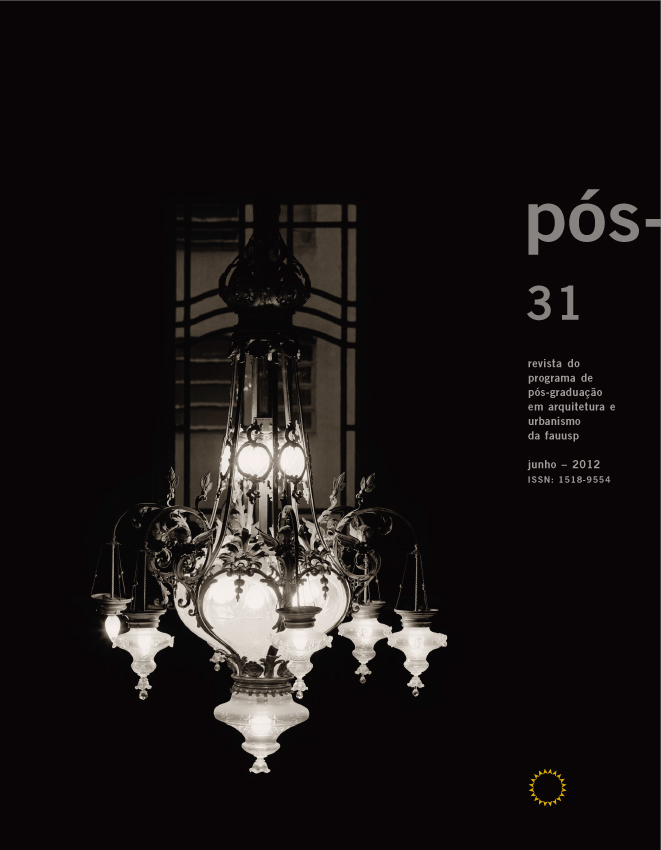BRATKE AND THE ICOMI´S CIVILIZATION PROJECT
DOI:
https://doi.org/10.11606/issn.2317-2762.v19i31p132-145Keywords:
Modern urbanism. Company town. Workers´housing. Work management. Discipline. Oswaldo Bratke. Serra do Navio. Vila Amazonas.Abstract
The paper discusses the sources of design solutions used by Oswaldo Bratke in the projects for Serra do Navio and Vila Amazonas. The projects were awarded by Icomi in the 1950’s, and distinguished themselves by a careful study and effective solutions related to thermal comfort. Without denying the innovations present in these projects, this article turns to an examination of the source of project and management solutions proposals by Bratke, by highlighting how some of them appear to be closely linked to usual procedures in the history of company towns, which reveal themselves restrictive regarding the autonomy of its residents. It is understood that if Bratke´s project reveals innovative design solutions consistent with the climate and local conditions, on the other side it shows to be extremely conservative about the overall design. It was adopted a rigid social division of space, design strategies to promote segregation of the singles and to avoid concentrations of residents in public spaces, suggested management measures to control the residents´s free time (as promotion of competitions relating to the conservation of houses and gardens, encouraging the cultivation of vegetable gardens in backyards, and so on). Serra do Navio, in particular, was conceived as an isolated community in which contact with “outsiders” should be avoided. In his writings on the two projects, Bratke shows sympathy for the strict discipline which is common in settlements of this kind, recommending only that the company exercises discreetly its controls. This attitude and the design and management procedures proposed by Bratke, are supported by his belief in a civilizing action in the jungle as a result of Icomi´s politics, based on a notion of “city” as a clean, orderly and safe place.Downloads
References
BRATKE, Oswaldo Arthur. Núcleos Habitacionais no Amapá. Acrópole. n. 326, p. 1-22, mar. 1966.
CAMARGO, Mônica Junqueira de. Princípios de Arquitetura moderna na obra de Oswaldo Arthur Bratke. 2000. 187p. Tese de Doutorado – Faculdade de Arquitetura e Urbanismo, Universidade de São Paulo, São Paulo, 2000.
CAMARGO, Mônica Junqueira de. Vila Amazonas e Serra do Navio. Por que tombar? DOCOMOMO Nordeste, 2008.
CORREIA, Telma de Barros. A Iniciativa Privada e a Transformação do Espaço Urbano e do
Território: Brasil, Década de 1950. In: ENCONTRO NACIONAL DA ANPUR, 13, 2009, Florianópolis. Anais... Florianópolis, 2009. CD-ROM.
FARAH, Flavio & FARAH, Marta Ferreira Santos. Vilas de mineração e de barragens no Brasil: retrato de uma época. São Paulo: ITP, 1993.
MEURS, Paul. Cenário: Vila Serra do Navio: é hora de tombar a cidade. AU Arquitetura & Urbanismo, São Paulo, n. 82, p. 20, fev.-mar. 1999.
OLIVEIRA, J. L. Fleury de. Amazônia: proposta para uma ecoarquitetura. 1989. 243p. Tese de Doutorado – Faculdade de Arquitetura e Urbanismo, Universidade de São Paulo, São Paulo, 1989.
RIBEIRO, Benjamin Adiron. Vila Serra do Navio: Comunidade urbana na selva amazônica: um projeto do arquiteto Oswaldo Arthur Bratke. São Paulo: Pini, 1992.
RODRIGUES, Roberta Menezes. Company Towns e empresas de extração e transformação mineral na Amazônia Oriental: especificidades, processos e transformações de um modelo urbanístico. 2001. Dissertação de Mestrado em Planejamento do Desenvolvimento Regional – UFPA-NAEA, Belém, 2001.
SEGAWA, Hugo; WISSENBACH, Vicente. Oswaldo Arthur Bratke. São Paulo: ProEditores, 1997.
Downloads
Published
Issue
Section
License

This work is licensed under a Creative Commons Attribution 4.0 International License.
DIADORIM - Diretório de Políticas Editoriais












